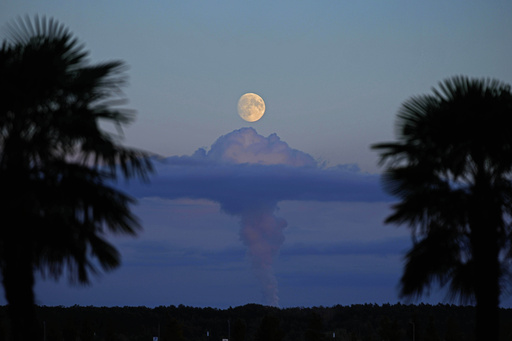
CAPE CANAVERAL, Fla. — A remarkable celestial event is approaching as October’s supermoon is set to be the closest full moon of the year, coinciding with the appearance of a comet.
This particular supermoon, the third in a series of four for 2024, will reach a distance of 222,055 miles (357,364 kilometers) from Earth on Wednesday night, appearing larger and more luminous than its predecessors in August and September. Its full phase will occur on Thursday.
Adding to the excitement, the comet Tsuchinshan-Atlas, first identified last year, is now prominent in the Northern Hemisphere, following its spectacular display in the Southern Hemisphere. While the brightness from the moon may diminish the visibility of the comet’s tail, viewing it after sunset remains a worthwhile endeavor, according to NASA’s Bill Cooke.
Cooke noted, “Typically, astronomers find it challenging to appreciate the full moon due to its brightness interfering with observations of other celestial bodies. While it’s the largest supermoon of the year, it’s hard to get too sentimental about it,” he expressed in an email.
Those interested in catching a glimpse of the comet should do so soon since its return is uncertain. However, those unable to view Thursday’s supermoon need not be disheartened, as the final supermoon of the year is scheduled to rise on November 15.
So, what qualifies a moon as “super”?
The term “supermoon” is more popular vernacular than a strict scientific classification. It refers to the occurrence of a full moon that coincides with the moon’s closest approach to Earth in its elliptical orbit, an event that typically happens three to four times annually.
Although a supermoon isn’t physically larger, it can appear so; scientists assert that the difference in size is often nearly indistinguishable.
When comparing this year’s supermoons, there has been a series of four.
The supermoon in August was located 224,917 miles (361,970 kilometers) away, while the one in September was almost 3,000 miles (4,484 kilometers) closer. Notably, a partial lunar eclipse also occurred during September’s event, where Earth’s shadow partially obscured the moon, giving it an intriguing appearance for many observers across the Americas, Africa, and Europe.
October’s supermoon stands out as the closest for the year at 222,055 miles (357,364 kilometers) from Earth, followed by the November supermoon at 224,853 miles (361,867 kilometers).
What can observers expect from this event?
Experts emphasize that only the most attentive stargazers can identify the minuscule differences in the moons, but the difference in brightness is stark, with a supermoon being up to 30% brighter than usual.
As interest in lunar exploration grows, with various countries sending landers and planning crewed missions, the moon shines ever more brightly in the public imagination.
